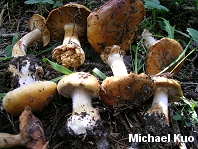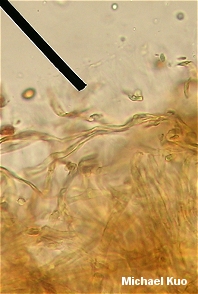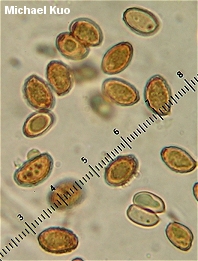| Major Groups > Gilled Mushrooms > Dark-Spored > Cortinarius > Cortinarius multiformis |

|
Cortinarius multiformis [Basidiomycetes > Agaricales > Cortinariaceae > Cortinarius ... ] by Michael Kuo Yet another conifer-associated, wishy-washy, yellowish Cortinarius with a bulbous stem base, Cortinarius multiformis features a hoary covering on the young cap--a result of the veil, reminiscent of the young cap of Cortinarius caperatus. However, the covering usually disappears quickly and, as North American Cortinarius pioneer Charles Kauffman (1918) puts it, "[t]his hoariness is best seen when the plants are growing in dry weather." Under the microscope Cortinarius multiformis features fairly small, nearly smooth spores. Description: Ecology: Mycorrhizal with conifers--especially spruces (but in Europe also reported under beech); growing alone, scattered, or gregariously; fall; apparently widely distributed in montane and northern North America. Cap: 4-10 cm; convex, becoming broadly convex or nearly flat; sticky when fresh; bald; when young with a hoary coating of whitish veil material that soon disappears; yellowish to brownish yellow or orangish brown. Gills: Attached to the stem; close; whitish at first, becoming dull grayish brown to rusty brown. Stem: 4-8 cm long; up to about 1.5 cm thick above; more or less equal above a swollen basal bulb that may or may not be somewhat rimmed and often disappears with maturity; whitish when young, but discoloring brownish; dry; bald or slightly hairy in places; often with a few rusty fibrils or a slight ring zone, but generally with a fairly sparse cortina. Flesh: Whitish. Odor and Taste: Odor often sweet, reminiscent of honey (especially in the base of the stem); taste not distinctive. Chemical Reactions: KOH brownish to rusty reddish on cap surface. Spore Print: Rusty brown. Microscopic Features: Spores 8-10 x 5-6 µ; ellipsoid; weakly verrucose. Pleuro- and cheilocystidia absent; cylindric to clavate marginal cells present. Pileipellis an ixocutis of clamped, ochraceous elements. REFERENCES: (Fries, 1818) Fries, 1838. (Saccardo, 1887; Kauffman, 1918; Kauffman, 1932; Smith, 1942; Smith, Smith & Weber, 1979; Moser, 1983; Arora, 1986; Phillips, 1991/2005; Breitenbach & Kränzlin, 2000; McNeil, 2006; Knudsen & Vesterholt, 2008.) Herb. Kuo 08140805. This site contains no information about the edibility or toxicity of mushrooms. |
© MushroomExpert.Com |
|
Cite this page as: Kuo, M. (2011, December). Cortinarius multiformis. Retrieved from the MushroomExpert.Com Web site: http://www.mushroomexpert.com/cortinarius_multiformis.html |


